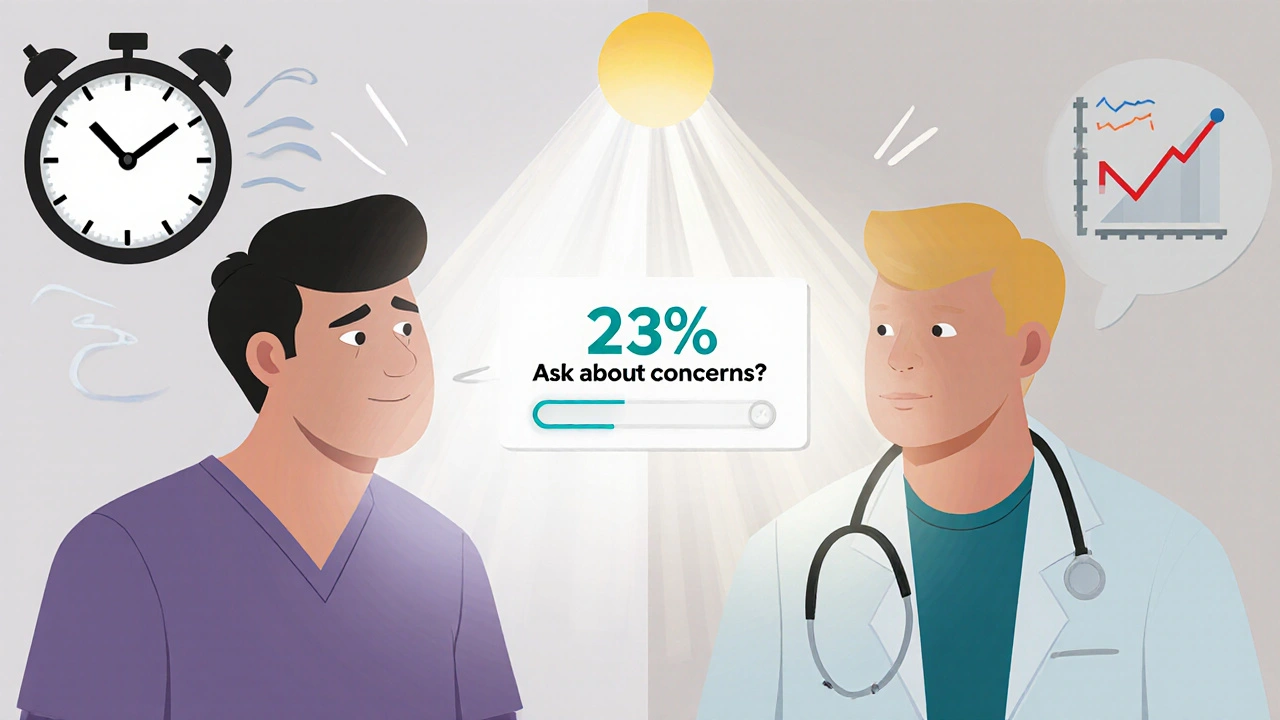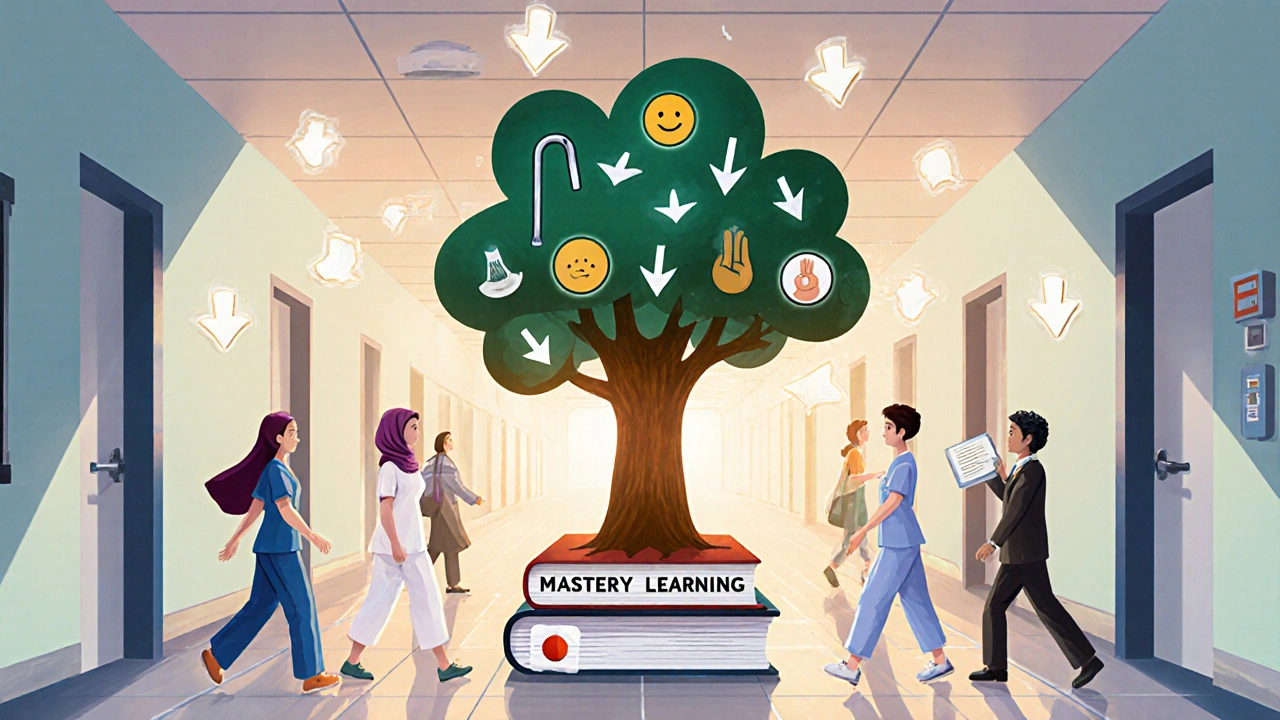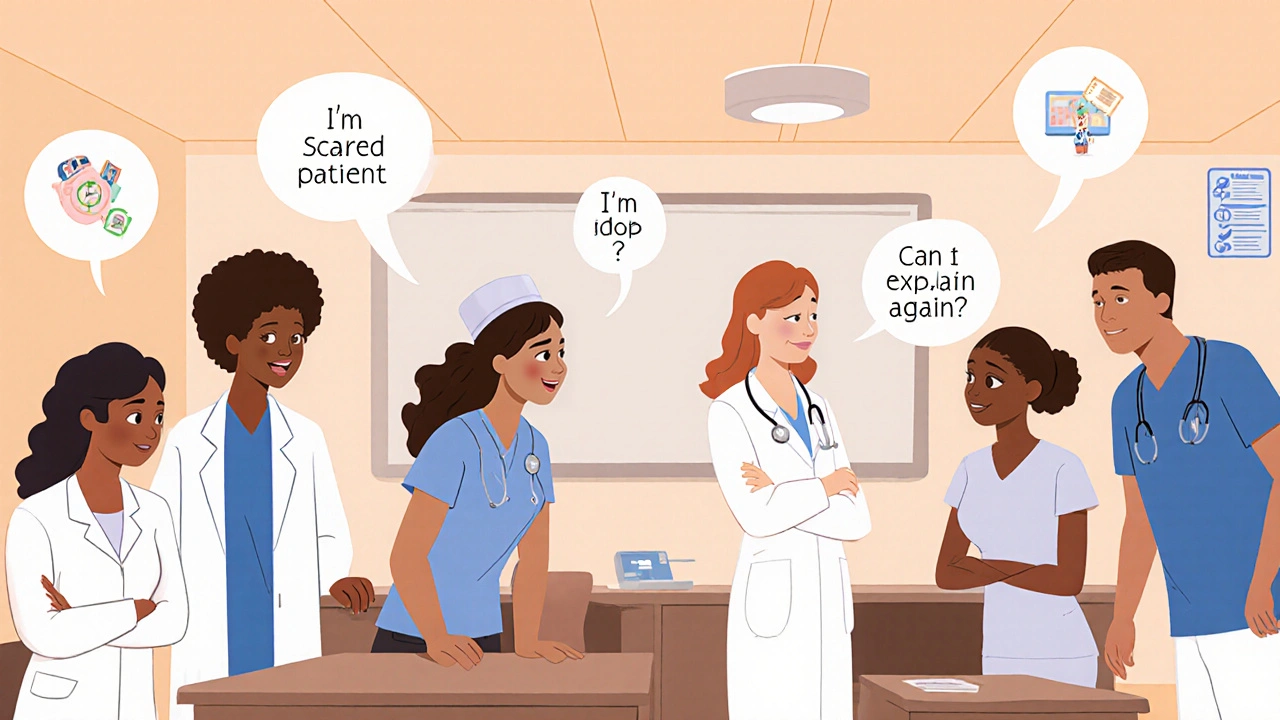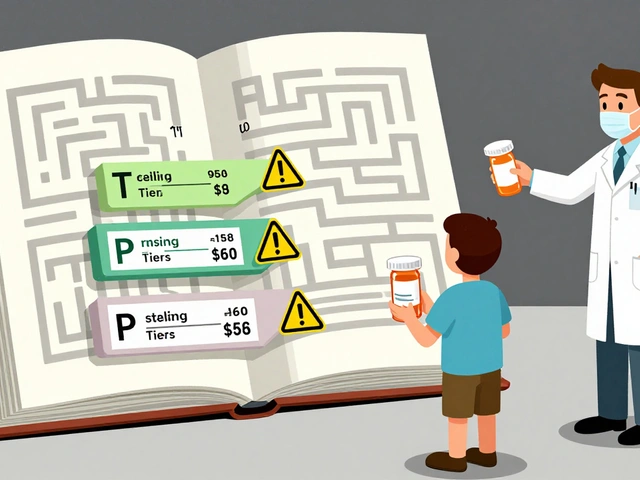When patients leave a doctor’s office feeling unheard, confused, or anxious, it’s rarely because the diagnosis was wrong. More often, it’s because the communication broke down. In fact, studies show that up to 80% of medical errors are tied to poor communication-not lack of skill or knowledge, but failure to connect. That’s why hospitals and health systems across the U.S. and Australia are turning to structured, institutional education programs to fix the problem at its source.
Why Communication Training Isn’t Optional Anymore
For years, healthcare focused on technical competence: accurate diagnoses, precise surgeries, effective medications. But data from the Agency for Healthcare Research and Quality (AHRQ) shows that communication failures contribute to 15-20% of adverse patient outcomes. That’s not a side issue-it’s a safety crisis. Patients who don’t understand their treatment plan are more likely to miss doses, show up late for follow-ups, or end up back in the ER. And when providers don’t listen well, they miss critical clues: a patient’s fear, a cultural belief, a financial barrier. The solution isn’t more time in appointments-most visits are still capped at 15 minutes. It’s better communication skills, taught systematically. That’s where institutional generic education programs come in. These aren’t one-off workshops. They’re formal, curriculum-based training embedded into hospital systems, medical schools, and nursing programs.What These Programs Actually Teach
Not all communication training is the same. Some focus on talking to patients. Others train teams to speak the same language. A few even prepare staff to handle media during a public health crisis. Take the Program for Excellence in Patient-Centered Communication (PEP) at the University of Maryland. It’s a 6.5-hour workshop accredited by the AMA, built on decades of research from the Academy of Communication in Healthcare. Trainees don’t just watch videos-they practice real scenarios. They learn how to elicit the patient’s story without interrupting, how to respond with empathy when someone says, “I’m scared,” and how to confirm understanding without saying, “Do you understand?”-a phrase patients often nod at even when they don’t. Mayo Clinic’s online course uses 12 standardized patient videos to teach boundary setting and non-verbal cues. Nurses learn how to say “no” to unreasonable demands without sounding cold. Doctors practice how to deliver bad news without rushing. One nurse practitioner reported a 40% drop in burnout after learning to set emotional boundaries. Then there’s Northwestern University’s Mastery Learning model. Medical students must hit an 85% proficiency score on communication assessments before moving forward. They do 4-6 simulation sessions during clinical rotations. The result? 37% higher skill retention at six months compared to traditional lectures. And it’s not just for doctors. The Society for Healthcare Epidemiology of America (SHEA) trains infection control specialists to communicate with the public during outbreaks. Their four-module course covers social media strategies, policy advocacy, and media interviews. One participant in Cleveland used what she learned to correct vaccine misinformation reaching over 50,000 people monthly.How These Programs Are Changing Outcomes
The numbers don’t lie. Hospitals that implement these programs see real changes:- 30% fewer malpractice claims among physicians who complete communication training (Johns Hopkins, 2019)
- 23% higher improvement in patient satisfaction scores with patient-centered programs like PEP
- 28% fewer patient complaints in residency programs using mastery learning (Northwestern, 2023)
- Correlation of r=0.78 between communication quality and patient satisfaction (Press Ganey, 2022)

The Gaps in Today’s Programs
Despite the progress, many programs still miss the mark. Only 12% track whether skills are used beyond six months. Most don’t measure how well staff apply what they’ve learned in real time. Some programs ignore interprofessional communication. AHRQ found that 65% of communication failures happen between nurses, doctors, pharmacists, and social workers-not between providers and patients. Yet few programs teach teams how to hand off care clearly or resolve conflicts without blame. Others lack cultural humility. AAMC’s 2023 review found that 60% of communication curricula don’t address health disparities. A patient from a different culture may not say “no” directly. A provider who doesn’t recognize that may assume agreement-and miss a red flag. And then there’s time. A 2023 AAMC survey found that 58% of healthcare workers say they know the skills but don’t have time to use them. One doctor summed it up: “I was trained to listen better. But my schedule still gives me 13.3 seconds before I interrupt.”How to Make These Programs Work
Successful programs follow a clear four-phase model from the Academy of Communication in Healthcare:- Needs assessment: Use patient surveys to find the biggest gaps. Is it explaining medications? Delivering bad news? Managing anger?
- Skills prioritization: Pick 3-5 high-impact behaviors to focus on. Don’t try to teach everything.
- Contextualized training: Use real cases from your own hospital. Don’t use generic role-plays.
- Workflow integration: Embed prompts into your EHR. A pop-up that says, “Did you ask the patient what concerns they have?” makes a difference.

The Future of Communication Training
The field is evolving fast. In 2024, UT Austin and TEPHI launched new modules focused on health equity communication, addressing the 28% satisfaction gap between white and minority patients. The Academy of Communication in Healthcare is testing AI tools that give instant feedback on tone, pacing, and empathy in recorded patient conversations. Early results show 22% faster skill acquisition. Telehealth is changing the game too. Thirty-five percent of new programs now include virtual communication training. How do you build trust over a screen? How do you read body language when the patient is on a shaky Zoom call? These are new challenges. And the push for mandatory training is growing. The National Academy of Medicine’s 2023 report called communication a “core healthcare function”-just like infection control or medication safety. If that becomes policy, every clinician will need to prove they’ve been trained.What You Can Do Now
If you’re a patient: Ask your provider, “What’s one thing I should do differently at home?” Then say, “Can you explain that again in a different way?” You have the right to understand. If you’re a provider: Start small. Pick one skill-listening without interrupting-and practice it for a week. Notice how the conversation changes. If you’re in administration: Don’t just buy a course. Build a system. Train champions. Track outcomes. Tie it to performance reviews. And fund it properly-only 42% of hospital programs have dedicated budgets. Communication isn’t a soft skill. It’s a clinical skill. And like any skill, it improves with training, practice, and feedback. The institutions that treat it that way will see fewer errors, happier patients, and stronger teams.What are institutional generic education programs in healthcare communication?
Institutional generic education programs in healthcare communication are structured, organization-wide training initiatives designed to improve how healthcare staff interact with patients, families, and each other. These programs are based on evidence-based curricula and often include simulations, role-playing, and feedback tools. They’re called "generic" because they’re not tied to one specialty-they apply to nurses, doctors, pharmacists, and administrative staff alike. Examples include the Program for Excellence in Patient-Centered Communication (PEP) and Mayo Clinic’s online communication course.
Do these programs really improve patient outcomes?
Yes. Studies show hospitals with formal communication training see 30% fewer malpractice claims, 23% higher patient satisfaction scores, and 28% fewer patient complaints in residency programs. Patients who understand their care plan are less likely to be readmitted, and staff report lower burnout. The link between communication quality and patient safety is strong enough that CMS now ties 30% of hospital reimbursement to communication scores on patient surveys.
Are these programs only for doctors?
No. While many programs target physicians, the most effective ones include nurses, pharmacists, social workers, and even administrative staff. Communication failures often happen between team members, not just between providers and patients. Programs like SHEA’s training focus on infection control specialists, while others train entire teams in handoff protocols and conflict resolution. Everyone who interacts with patients benefits from better communication skills.
Why do some healthcare workers say they don’t have time to use these skills?
Time pressure is real. Doctors average only 13.3 seconds before interrupting patients-even after training. Many feel they can’t slow down without falling behind schedule. But the fix isn’t more time-it’s better efficiency. Simple tools like EHR prompts (“Did you ask about concerns?”) and peer modeling help embed skills into existing workflows. Training that’s integrated into daily routines, not added on top, has the highest adoption rate.
What’s the biggest gap in current communication training?
The biggest gap is cultural humility and equity. Sixty percent of programs don’t address how language, race, or cultural beliefs affect communication. A patient from a different background may not say "no" directly, or may avoid asking questions out of fear or respect. Training that ignores these dynamics misses the mark. Newer programs are adding modules on health equity, but they’re still the exception, not the rule.
How can hospitals make these programs sustainable?
Sustainability requires three things: funding, leadership, and integration. Only 42% of hospital programs have dedicated budgets. To fix that, hospitals need to tie communication outcomes to performance metrics, fund internal trainers, and appoint communication champions in each unit. Programs that are embedded into onboarding, EHR systems, and quality reviews last longer than one-off workshops. Partnerships with academic centers, like Mayo Clinic’s collaboration with SHEA, also help share resources and expertise.





November 10, 2025 AT 23:58 PM
Let’s be real-80% of medical errors are from communication? That’s not a bug, it’s a feature of a system designed to maximize throughput, not patient care. The data’s solid, but nobody’s addressing the root: hospitals are corporations first, caregivers second. Training nurses to say ‘I hear you’ won’t fix a 12-minute visit with 17 patients. The real metric? Time per patient. Not empathy scores. Stop polishing the brass on the Titanic.
November 12, 2025 AT 15:04 PM
OMG this is why AMERICA is falling behind!! We got all these fancy 'PEP' programs but no one’s fixing the REAL issue-illegal aliens clogging ERs with no insurance and demanding translators for their 3rd cousin’s headache. Also, why are we training PHARMACISTS to talk? They’re not therapists!! This is woke med nonsense. We need more cops in hospitals, not more ‘cultural humility’ lectures. #AmericaFirstHealthcare
November 12, 2025 AT 21:16 PM
Big fan of the mastery learning model-especially at Northwestern. The 37% retention bump is huge. But here’s the kicker: most hospitals don’t track long-term skill use. I’ve seen teams do great in training, then revert to ‘just get it done’ mode after 3 months. The fix? Embed prompts in EHRs. A simple pop-up: ‘Did you ask what they’re most worried about?’-it takes 5 seconds. Also, use peer champions. Nothing beats seeing your boss do it right. 🙌
November 14, 2025 AT 02:45 AM
Yesss!! This is so true. Just tryna listen for 10 sec without gettin interrupted? Hard. But I started doin it for a week-my patients actually told me stuff I never heard before. One lady said she wasn’t takin her meds ‘cause she was scared of the side effects but was too shy to ask. Changed everything. Keep it simple. Listen. You don’t need a 6-hour course. 😊
November 15, 2025 AT 15:58 PM
It is deeply concerning that the author conflates patient satisfaction with clinical outcomes. While improved communication may correlate with higher HCAHPS scores, correlation is not causation. Moreover, the notion that ‘communication is a clinical skill’ is a dangerous semantic slide. Medicine is grounded in evidence-based intervention, not emotional validation. Training physicians to be therapists undermines the integrity of the profession and incentivizes performative empathy over diagnostic rigor.
November 17, 2025 AT 09:52 AM
Can someone clarify the difference between ‘institutional generic education programs’ and regular training? The term ‘generic’ is confusing-is this meant to imply it’s low-effort or universally applicable? Also, why is there no data on cost per trained clinician? If these programs cost $25k per person and only reduce readmissions by 5%, is it worth it? And what’s the ROI on ‘cultural humility’ modules? I need numbers, not anecdotes.
November 18, 2025 AT 23:08 PM
As someone who has led communication training for over a decade across three teaching hospitals, I can say with certainty that the most successful initiatives are those that are not imposed from above, but grown from within. The key is identifying respected, experienced clinicians-often mid-career nurses or senior residents-who naturally embody empathetic communication. When these individuals are empowered to lead peer-to-peer sessions, participation increases by 400%. It’s not about the curriculum-it’s about trust. And trust is built through consistency, not PowerPoint slides. Also, please stop calling it ‘soft skills.’ It’s cognitive and emotional labor. It’s hard. And it’s essential.
November 20, 2025 AT 17:23 PM
So let me get this straight-we’re spending millions training doctors to say ‘I hear you’ while patients are dying because their insulin was never refilled because the front desk didn’t call? This isn’t training. This is theater. And the worst part? The people who need this training the most-the ones who are already burned out-are the ones who can’t afford to sit through a 6.5-hour workshop because they’re working 80-hour weeks. This is performative activism dressed up as healthcare reform. Someone’s getting paid. It’s not us.
November 22, 2025 AT 08:44 AM
I appreciate the depth of this analysis, but I must emphasize: the absence of interprofessional communication training is a systemic failure. We are training nurses to speak to patients, but not to physicians. We are training pharmacists to explain dosing, but not to resolve conflicts with residents. The handoff between units is a minefield-and it’s where most errors occur. We need mandatory, recurring team-based simulations that include everyone from unit clerks to hospital administrators. And yes, we need funding. Only 42% have budgets? That’s not innovation. That’s negligence. Let’s stop treating communication like a bonus feature and start treating it like oxygen.
November 22, 2025 AT 13:54 PM
I used to be a nurse. I saw patients cry because they didn’t understand their diagnosis. I saw doctors rush out because they were ‘behind.’ But then I started asking: ‘What’s the story behind the symptom?’ Not ‘What’s your pain level?’-but ‘What’s keeping you up at night?’ That one shift changed everything. Communication isn’t a skill. It’s a way of seeing people. And if we forget that, we’re not healing-we’re just managing symptoms. I’m not saying we need more training. I’m saying we need more humanity. And that doesn’t come from a curriculum. It comes from remembering we’re all just trying to survive.
November 23, 2025 AT 00:36 AM
Wait so if 65% of errors are between staff, why are we training doctors to talk to patients? Shouldn’t we be training nurses to tell docs ‘you missed the fever’ without getting yelled at? Also, why no data on how many docs actually use these skills? Just sayin.
November 24, 2025 AT 22:49 PM
I work in a rural ER. We don’t have fancy workshops. We have a nurse who sits with patients who are scared. She doesn’t have a title. She just shows up. And she’s the reason people come back here instead of driving 90 minutes to the city. I think the real program is the person who remembers your name. Not the curriculum. Not the pop-up. Just… someone who cares enough to pause.
November 26, 2025 AT 06:52 AM
As someone from India working in a U.S. hospital, I’ve seen both systems. In India, we don’t have formal communication training, but we have something better: family involvement. Relatives sit with patients for days. They ask questions. They double-check meds. They translate. In the U.S., patients are alone, overwhelmed, and expected to understand complex jargon in 10 minutes. Maybe the answer isn’t more training for providers-but more support for families. Let them in. Let them help. That’s real communication.
November 26, 2025 AT 21:38 PM
Can we talk about telehealth? I had a patient last week on Zoom who kept looking away. I thought she was distracted. Turns out she was reading lips because she’s hard of hearing and didn’t have her hearing aids. We didn’t ask. We just assumed. We need training for virtual cues. Like… how do you know if someone’s nodding because they get it… or because they’re too scared to say they don’t?